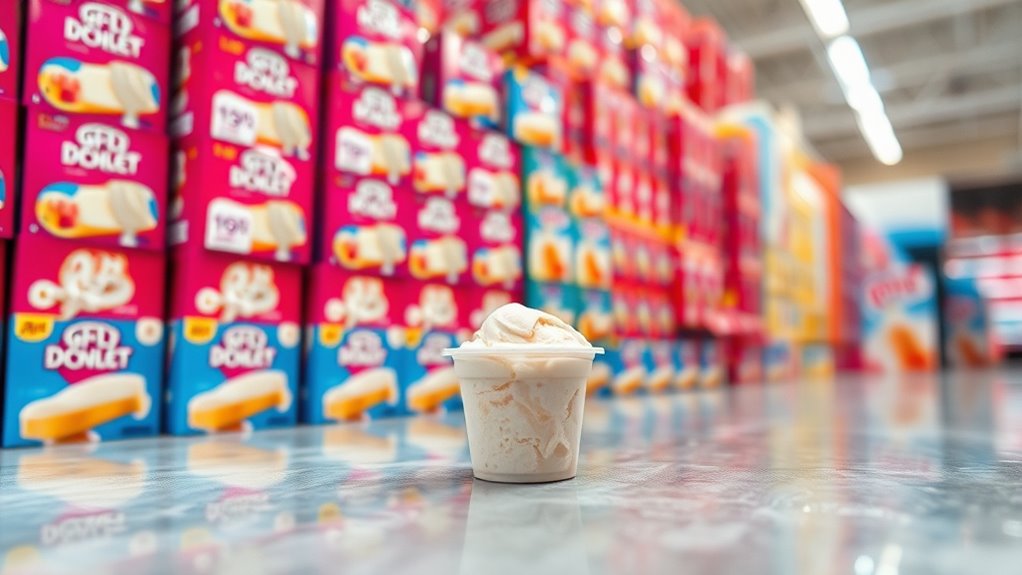When you shop in the frozen dessert aisle, it’s easy to fall for portion-size myths shaped by marketing and visuals. Mindful eating encourages you to pause, recognize your true hunger, and choose smaller servings that satisfy without overeating. Pay close attention to labels, address emotional triggers, and make deliberate choices based on your needs. By staying present and aware, you can better navigate these myths—and there’s more to discover that can help you make healthier, mindful decisions.
Key Takeaways
- Many frozen desserts come in large packages, but mindful eating encourages choosing smaller portions to prevent overeating.
- Marketing visuals often exaggerate portion sizes, leading to misconceptions about appropriate servings.
- Reading labels helps identify true portion sizes and sugar content, challenging the myth that bigger is better.
- Emotional triggers can cause automatic larger servings; awareness supports selecting mindful, moderate portions.
- Practicing presence while serving or eating frozen desserts promotes better portion control and enjoyment.

Mindful consumption is about paying close attention to your nourishment and the experience of eating, rather than rushing through meals or eating on autopilot. When you’re in the frozen dessert aisle, this awareness becomes especially important. It’s easy to get caught up in marketing messages or the visual appeal of perfectly scooped ice cream, but mindful eating urges you to pause and consider what you’re truly craving. Instead of automatically grabbing a large tub, take a moment to reflect on your hunger cues and emotional triggers that might influence your choice. Are you reaching for dessert out of genuine hunger or because of stress, boredom, or habit? Recognizing these emotional triggers helps you make more conscious decisions, avoiding mindless overeating.
Understanding nutrient awareness is a key part of mindful eating in this context. Many frozen desserts are marketed as indulgent treats, but they also contain ingredients that impact your health. By paying close attention to labels, you become more aware of the nutritional content—sugar levels, portion sizes, and additives—that influence how much you eat and how you feel afterward. This knowledge empowers you to choose options that satisfy your sweet tooth without derailing your health goals. For instance, noticing that a small serving of frozen yogurt provides enough sweetness and texture can help you resist the temptation to go back for seconds, which often happens when you’re not paying attention.
Your emotional state plays a significant role in how you approach dessert choices. If you’re feeling stressed or anxious, you might subconsciously seek comfort in larger portions or richer flavors. Mindful eating encourages you to recognize these emotional triggers before reaching for a treat. Ask yourself whether you’re genuinely hungry or if your emotions are steering you toward food for comfort. This awareness allows you to address underlying feelings more directly, rather than using food as a quick fix. You might find that a brief walk, deep breathing, or even a glass of water can help manage emotional triggers more effectively than impulsively eating a large portion of ice cream.
In the frozen dessert aisle, practicing mindful eating means making deliberate choices based on nutrient awareness and emotional insight. It’s about being present with your food, understanding your body’s signals, and resisting the impulse to eat on autopilot. Additionally, portion control plays a crucial role in maintaining a balanced diet and preventing overeating. By doing so, you foster a healthier relationship with food, enjoy desserts more fully, and avoid the pitfalls of portion-size myths that often lead to overeating. With each visit to the freezer section, you have the opportunity to practice mindfulness, making choices that nourish both your body and your emotional well-being.
Frequently Asked Questions
How Can I Resist Impulse Buys in the Frozen Dessert Aisle?
To resist impulse buys in the frozen dessert aisle, recognize impulse triggers like catchy packaging or emotional cravings. Before shopping, identify your emotional triggers and plan healthy alternatives. Bring a list and stick to it, avoiding temptation zones. When cravings hit, distract yourself or choose a smaller portion. Staying mindful helps you make intentional choices, reducing the chance of impulsively grabbing that tempting ice cream.
What Are Healthy Alternatives to Traditional Ice Cream?
When seeking healthy alternatives to traditional ice cream, you can try dairy alternatives like coconut milk or almond milk-based frozen desserts. These options are often lower in saturated fats and calories. Additionally, look for options sweetened with natural sweeteners like honey or maple syrup, which add flavor without the refined sugar spike. These choices satisfy your sweet tooth while supporting your health goals.
How Do I Identify Truly Portion-Controlled Frozen Desserts?
You’re about to conquer the frozen dessert aisle like a snack ninja! To spot truly portion-controlled options, check the serving sizes on ingredient labels—some look tiny but are actually meant for multiple servings. Aim for single-serving packages or compare the calorie count per serving. Avoid oversized containers, and look for products with clear, honest labels. This way, you’ll enjoy your treat without overdoing it.
Does Eating Frozen Desserts Impact Blood Sugar Levels?
Eating frozen desserts can impact your blood sugar levels because of their sugar content. High sugar levels can cause a rapid glycemic response, leading to quick spikes in blood glucose. To manage this, check the label for added sugars and opt for options with lower sugar content. Balancing your intake and choosing desserts with healthier ingredients can help keep your blood sugar more stable.
Can Mindful Eating Help Reduce Cravings for Sweet Treats?
Imagine your cravings as a gentle river, flowing steadily. Mindful eating acts as a sturdy bridge, helping you cross without guilt or overwhelm. It promotes guilt-free indulgence and sweet craving management by encouraging awareness of hunger and fullness. When you slow down, savor each bite, and listen to your body, you reduce impulsive treats. This mindful approach transforms cravings into signals, making sweet treats a conscious, joyful choice rather than an impulsive escape.
Conclusion
By embracing mindful eating, you become the navigator steering through the icy waters of the frozen dessert aisle, steering clear of the iceberg of portion-size myths. Instead of letting assumptions sink your good intentions, you can savor each bite with awareness and gratitude. Remember, you hold the paddle—your mindful choices shape the journey. So, when facing temptations, trust your inner compass, and steer toward nourishing, joyful moments. Your mindful approach turns every treat into a conscious celebration of balance.









